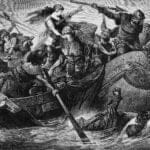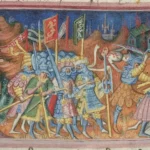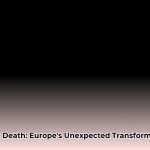Imagine Europe gripped by a nightmare between 1347 and 1352. The Black Death wasn’t just a disease; it was a societal earthquake that eradicated a third of the population. This article explores the devastation, survival attempts, and the continent’s unexpected reconstruction. Delve into economic collapse, power struggles, and surprising labor market changes, uncovering the complex legacy shaping today’s world. The later spread of information was also impacted, as seen with the printing press. Read on to discover how the Black Death became a catalyst for profound and lasting change.
The Black Death: How it Reshaped the Social and Economic Fabric of Europe – Unearthing Societal Transformation
Between 1347 and 1352, the Black Death ravaged Europe, unleashing a societal earthquake that forever altered its course. The scale of loss was immense, with thriving towns becoming ghost towns and once vibrant families shattered beyond recognition. This wasn’t merely a historical event confined to textbooks; it was a human tragedy of unprecedented proportions, leaving an enduring scar on the collective psyche of the continent. Discover how this devastating crisis became a pivotal turning point, ushering in an era of transformation and laying the foundations for modern Europe.
A Population Crash and its Immediate Aftermath – Examining Labor Shortages and Economic Disruptions
The plague’s virulence and rapid spread resulted in a staggering 30 to 60 percent population decline across Europe. This catastrophic demographic collapse triggered a massive labor shortage, leaving insufficient workers to maintain essential functions, from agriculture to craftsmanship. The consequences were far-reaching, disrupting trade, food production, and the very fabric of daily life. Peasants, previously bound as serfs with limited rights, suddenly gained unprecedented leverage, negotiating for better wages and improved working conditions. In some regions, wages soared by as much as 50 percent, challenging the long-established economic order. This dramatic shift struck at the heart of the feudal system, a system that had defined life for centuries, forcing a re-evaluation of social and economic structures.
The Cracks in the Feudal Foundation – Analyzing Power Imbalances and the Rise of a Market Economy
For centuries, feudalism had rigidly governed Europe, with powerful landowners wielding absolute authority over obligated serfs tied to the land. The Black Death shattered this hierarchical structure, weakening the landowners’ control due to the severe shortage of available workers. Landowners were compelled to offer improved terms and greater freedoms to attract and retain labor, leading to the gradual erosion of traditional feudal obligations. As the old system crumbled under the weight of demographic and economic pressures, a new economic order began to emerge, characterized by increased mobility, wage labor, and the nascent development of a market economy. This marked a significant shift in power dynamics, laying the groundwork for future social and economic transformations.
More Than a Disease: A Spiritual and Social Upheaval – Exploring Cultural Shifts and Religious Disillusionment
Beyond the physical devastation and economic turmoil, the Black Death triggered profound spiritual and social upheaval. The Church, which had long served as a source of solace and guidance, struggled to explain the widespread suffering and offer effective solutions, leading to a loss of faith among many and the rise of extremist movements like the Flagellants. Fear and uncertainty fueled the scapegoating of marginalized groups, particularly Jewish people, who were wrongly blamed for the plague’s spread, resulting in horrific acts of violence and persecution. Despite these disruptions, the crisis also created unexpected opportunities for social mobility, challenging traditional hierarchies and making European society more dynamic and adaptable. This period underscored how times of crisis can both exacerbate existing social inequalities and create new pathways for change and innovation.
Seeds of Change: A New Era Dawns? – Understanding Long-Term Impacts and the Dawn of the Renaissance
The Black Death’s immediate aftermath was undeniably catastrophic, leaving a trail of death, destruction, and despair across Europe. Yet, paradoxically, it also laid the foundation for lasting and transformative change. The decline of feudalism, the rise of wages, and the questioning of religious authority created a fertile climate for innovation and social progress. Some historians argue that the Black Death indirectly contributed to the Renaissance by fostering a renewed emphasis on humanism, individual achievement, and the pursuit of knowledge and exploration. Could this devastating tragedy, in an unforeseen twist of fate, be the unexpected catalyst that propelled Europe towards a new era of cultural, intellectual, and economic flourishing?
Looking Back: A Legacy of Transformation – Tracing Enduring Influence and Lessons for the Future
The Black Death’s legacy is multifaceted and enduring, a complex story of adjustment, adaptation, and societal transformation. Its profound influence touched nearly every facet of European life, leaving a lasting mark on social structures, economic systems, cultural values, and religious beliefs. The devastating loss of life forced monumental changes, leading to the emergence of a new Europe, characterized by greater social mobility, economic dynamism, and a more critical approach to established institutions. The Black Death serves as a potent reminder of the fragility of human societies, the potential for progress amidst immense tragedy, and the importance of resilience in the face of unprecedented challenges.
Table: Short-Term and Long-Term Effects of the Black Death
| Stakeholder Group | Short-Term Impacts (0-1 year) | Long-Term Impacts (3-5 years+) |
|---|---|---|
| Peasants/Laborers | Significantly higher wages, less harsh working conditions, increased mobility and migration to urban centers, greater bargaining power with landowners | Increased social mobility, some escaped serfdom entirely, improved living standards for many, greater opportunities for land ownership and economic advancement |
| Landowners/Nobility | Severe labor shortages, unsuccessful attempts to control wages and suppress peasant demands, significant adjustments to farming practices, declining revenues and economic hardship | Diminished power and influence, adaptation to a market-based economy, potential loss of land and social status, increased reliance on wage labor and tenant farming |
| Church Officials/Clergy | Loss of faith among many, crisis of credibility and authority, high mortality rates among clergy members responsible for administering last rites, widespread questioning of religious doctrine and practices | Reform movements within the Church, increased criticism from secular intellectuals, questioning of Church authority and wealth, rise of alternative religious movements and mystical traditions |
| Governments/Monarchs | Emergency measures to address the crisis, widespread social unrest and peasant revolts, economic instability and disruption of trade, challenges to traditional governance structures and legal systems | Stronger centralized power in some regions, development of more powerful nation-states, significant economic restructuring and adaptation, implementation of new laws and regulations to address social and economic issues |
How did the Black Death impact medieval peasant wages and living standards? – Analyzing Economic Consequences and Regional Variations
The Black Death dramatically altered the social and economic landscape of medieval Europe, creating an unprecedented demographic crisis. The significant population loss led to severe labor shortages, which, in turn, resulted in improved wages and living conditions for many peasants. However, the precise impact of these changes varied considerably by region and social group, reflecting the diverse economic and political structures across the continent. Understanding these nuances is crucial for comprehending the full scope of the plague’s transformative effects. The plague’s long-term effects reshaped power dynamics and triggered societal shifts that continue to fascinate historians today.
Key Takeaways:
- The Black Death, a devastating pandemic, dramatically altered the social and economic landscape of medieval Europe, particularly in the years between 1347 and 1351.
- A significant portion of Europe’s population perished, creating an unprecedented labor shortage that disrupted traditional economic relationships.
- This labor shortage unexpectedly led to improved wages and living conditions for many peasants, who found themselves in a position to demand better terms from landowners.
- However, the impact was uneven, varying significantly by region and social group, depending on local economic conditions, political structures, and social hierarchies.
- The plague’s long-term effects reshaped power dynamics, weakened feudalism, and triggered societal shifts that continue to fascinate historians and shape our understanding of medieval Europe.
A World Transformed: The Black Death’s Demographic Devastation – Examining Mortality Rates and Social Impact
Between 1347 and 1351, the Black Death, likely caused by the bacterium Yersinia pestis, the agent responsible for the bubonic plague, swept across Europe with devastating force, decimating its population and leaving an indelible scar on the continent. With mortality rates estimated between 30-60%, villages were wiped out, families were shattered, and entire communities were left reeling from the loss. The immediate impact was devastating, disrupting agriculture, trade, and all aspects of daily life, creating a sense of fear and uncertainty that permeated every level of society.
The Unexpected Ripple Effect: How did the Black Death impact medieval peasant wages and living standards? – Discussing Labor Dynamics and Economic Transformation
The massive loss of life led to a severe labor shortage, fundamentally altering the dynamics of the medieval economy. Peasants, once bound to the land and subject to the whims of their lords, gained unprecedented bargaining strength, shifting the balance of power between landowners and laborers. Landowners, desperate to maintain production, had to offer significantly higher wages and better working conditions to attract and retain scarce labor. This meant improved living conditions, greater economic opportunities, and a glimmer of hope for a brighter future for many peasants, who had previously been trapped in a cycle of poverty and servitude. The impact varied regionally, with some landowners attempting to impose old laws and customs to suppress wages, but the overwhelming need for labor often forced them to make concessions, contributing to the gradual erosion of the feudal system.
A New Social Order: Beyond Wages – Evaluating Social Mobility and Changing Power Structures
The Black Death accelerated the decline of the manorial system, further weakening the already fragile foundations of feudal power structures and paving the way for a more dynamic and market-oriented economy. Peasants, emboldened by their newfound economic leverage, gained previously unimaginable social mobility, negotiating terms with landowners, migrating to urban centers in search of better opportunities, and challenging traditional hierarchies. This newfound agency fueled social unrest and uprisings in some regions, as peasants fought to maintain their improved status and resist attempts by the nobility to reimpose old restrictions. How did this sudden and dramatic shift change the dynamics of medieval society, and what were the long-term consequences for the social and political landscape of Europe?
The Long Shadow: Lasting Impacts – Assessing Long-Term Societal Changes and Historical Significance
The Black Death’s widespread and long-lasting impact fundamentally reshaped European society, leaving a legacy that continues to resonate centuries later. The plague’s profound effect on peasant wages and living standards was a key element of this transformation, contributing to the rise of a more independent and economically empowered peasantry, the decline of feudalism, and the emergence of new social and economic structures that laid the groundwork for the modern era. While the short-term devastation was immense and undeniable, the long-term consequences were incredibly complex and far-reaching, demonstrating that unexpected and transformative change can arise even from the most tragic and devastating events in human history.
The Black Death’s Impact on Religious Authority and Practices in 14th Century Europe – Investigating Religious Reactions and Societal Consequences
The Black Death, which swept across Europe and the Near East in the mid-14th century, drastically altered religious landscapes, challenging long-held beliefs, undermining established institutions, and shaping new forms of religious expression. Christian and Islamic communities alike grappled with the devastating consequences of the pandemic, sharing some common responses but also diverging in their theological interpretations and practical approaches. Christianity’s view of the plague as divine punishment weakened the Church’s authority and fostered social divisions, while Islam’s emphasis on divine will and resilience fostered community cohesion and spiritual fortitude, spurring significant social and political changes.
Key Takeaways:
- The Black Death, a devastating pandemic that ravaged Europe and the Near East in the 14th century, drastically altered religious landscapes and challenged established beliefs.
- Both Christian and Islamic communities shared some common responses to the plague, such as prayer, acts of charity, and attempts to appease divine forces, but their theological interpretations differed significantly.
- Christianity’s interpretation of the plague as divine punishment for sin led to increased self-flagellation, scapegoating of minority groups (particularly Jewish communities), and a weakening of the Church’s authority and moral standing.
- Islam’s perspective, emphasizing divine will, acceptance of God’s plan, and the concept of martyrdom for those who succumbed to the disease, fostered greater community cohesion, resilience, and spiritual fortitude.
- The pandemic’s impact on religious leadership, institutions, and practices was profound and long-lasting, contributing to social unrest, political upheaval, and the questioning of traditional values and norms.
- The event spurred significant social and political changes, including the rise of new religious movements, the reform of existing institutions, and a re-evaluation of the relationship between faith, reason, and human suffering.
A Shared Crisis, Divergent Responses – Comparing Religious Reactions and Theological Interpretations
In 1347, the Black Death began its relentless march across Europe, leaving death and devastation in its wake and prompting profound religious responses from both Christian and Muslim societies. Both groups turned to prayer, repentance, and acts of charity in an attempt to alleviate suffering and seek divine intervention. However, their underlying theological interpretations of the plague differed dramatically, shaping their responses in distinct and sometimes conflicting ways. In Christian Europe, many viewed the plague as a direct punishment from God for the sins of humanity, fueling waves of religious fanaticism, self-mortification, and the persecution of those deemed to be outside the favor of divine grace.
Cracks in the Church’s Foundation – Analyzing Religious Authority and Institutional Challenges
The Church, already facing challenges to its authority and credibility in the years leading up to the Black Death, saw its power further eroded by the pandemic. The massive death toll among clergy, the apparent ineffectiveness of prayers and rituals, and the inability of the Church to provide answers or solace in the face of overwhelming suffering led to widespread disillusionment and questioning of traditional religious beliefs. Was their God failing them in their hour of greatest need? The questioning of the established order paved the way for later religious and political upheavals, including the Protestant Reformation and the rise of secular humanism. The Black Death’s profound and far-reaching impact highlights the vulnerability of religious institutions during times of crisis and the potential for such events to trigger fundamental shifts in faith, values, and social norms.
Resilience in the Face of Death – Exploring Islamic Perspectives and Community Cohesion
In contrast to the fractured and often divisive response in Christian Europe, many Islamic communities saw the plague as a test of faith, an opportunity for spiritual purification, or even a form of martyrdom, focusing on communal prayer, acts of charity, and acceptance of God’s will as the ultimate arbiter of human destiny. This perspective fostered social cohesion, resilience, and a sense of shared purpose in the face of overwhelming adversity, emphasizing the importance of faith, community, and acceptance in navigating times of crisis. The differing responses in Christian and Islamic societies highlight how religious beliefs and cultural values can profoundly impact crisis handling and shape the long-term consequences of pandemics.
Unanswered Questions – Discussing Historical Debates and Interpretative Challenges
Historians continue to debate the effectiveness of various religious responses to the Black Death, grappling with questions about the role of faith, the impact of theological interpretations, and the consequences of social divisions and religious persecution. Did prayer offer genuine protection against the plague? Did theological interpretations alter the disease’s progression or influence mortality rates? What was the true extent of scapegoating, particularly against Jewish communities, and how did such actions impact social and political structures? Rigorous analysis of primary sources, including religious texts, chronicles, and personal accounts, is essential for understanding these complex issues and avoiding simplistic generalizations. The Black Death reshaped societal and religious structures, leaving an indelible mark on European and Near Eastern history and prompting ongoing scholarly inquiry.
A Legacy of Change – Evaluating Societal Transformations and Enduring Lessons
The Black Death altered the relationship between people and religious authorities, triggering profound shifts in social structures, power dynamics, and cultural values. The legacy of this devastating pandemic continues to shape our understandings of crisis, resilience, and faith, offering valuable insights for navigating the challenges of the modern world. Understanding this history prepares us for future challenges, fosters community resilience, and encourages a more critical and nuanced approach to the intersection of religion, society, and human suffering.
Demographic Shifts and Urban Development After the Black Death in Western Europe – Investigating Demographic Consequences and Long-Term Transformations
From 1347 to 1352, the Black Death ravaged Europe, leaving an indelible mark on its social, economic, and demographic landscape. The plague’s impact extended far beyond the sheer death toll, fundamentally altering the course of European history and shaping the continent in ways that continue to resonate today. Let’s explore the profound societal adaptations, demographic shifts, and urban transformations that emerged in the wake of this devastating pandemic.
Key Takeaways:
- The Black Death drastically reduced Europe’s population, particularly in densely populated urban centers, with mortality rates ranging from 30% to 60% in many regions.
- The ensuing labor shortages empowered peasants and weakened the traditional feudal system, leading to increased wages, greater social mobility, and a decline in serfdom.
- Urban centers experienced initial devastation and population decline, followed by a demographic shift and gradual recovery, with new patterns of migration, trade, and economic activity.
- Agricultural practices adapted toward greater efficiency, with landowners adopting new technologies and shifting towards less labor-intensive forms of farming, such as animal husbandry.
- The market economy expanded in response to scarcity, with increased demand for goods and services, new entrepreneurial opportunities, and the growth of trade networks.
- The Black Death’s legacy continues to shape our understanding of pandemics, social change, and the resilience of human societies in the face of unprecedented challenges.
The Crumbling of the Feudal System – Discussing Labor Dynamics and Social Hierarchies
The plague, with its indiscriminate reach, struck all classes of society, blurring traditional social distinctions and challenging established hierarchies. The massive population decline created unprecedented labor shortages, empowering peasants and weakening the foundations of serfdom. Higher wages became the norm, altering power dynamics between landowners and peasants, contributing to the gradual erosion of feudalism and the emergence of a more market-driven economy. How did this shift in power dynamics impact the social and political landscape of medieval Europe?
Cities: From Desolation to Rebirth – Examining Urban Transformation and Demographic Shifts
European cities, initially devastated by the plague and transformed into virtual ghost towns, experienced a remarkable resurgence in the decades following the Black Death. Demographic Shifts and Urban Development After the Black Death in Western Europe led to an unexpected transformation, with new patterns of migration, trade, and economic activity shaping the urban landscape. The labor shortage increased the value of skilled workers, creating greater social mobility and attracting new residents to urban centers. How did these changes impact the physical environment, social structure, and economic opportunities within European cities?
A New Economic Order – Evaluating Agricultural Innovation and Market Expansion
The aftermath of the Black Death spurred agricultural innovation and economic diversification as landowners and farmers sought to adapt to the changed circumstances. With fewer laborers available, landowners shifted towards more efficient, less labor-intensive farming techniques, such as crop rotation, improved irrigation, and the use of animal-powered machinery, laying the groundwork for future agricultural advancements. The disruption also accelerated the shift towards a market-oriented economy, with increased specialization, trade, and the growth of merchant networks. Scarcity led to price increases, creating new entrepreneurial opportunities and stimulating economic growth in some regions. How did these economic transformations impact the lives of ordinary people and shape the future of European society?
The Long Shadow of the Plague – Assessing Historical Impact and Enduring Lessons
The pandemic rippled across generations, leaving a lasting legacy of economic chaos, demographic decline, and social transformation. Demographic Shifts and Urban Development After the Black Death in Western Europe created a drastically altered society, weakening feudalism, shifting economic structures, and changing social hierarchies. The Black Death became a catalyst for significant social and economic changes, offering a stark reminder of the vulnerability of human societies in the face of unforeseen catastrophes and the resilience of the human spirit in adapting to new realities. What lessons can we learn from this devastating period of history, and how can we apply those lessons to the challenges of the modern world?
- Understand the Dunning-Kruger Effect: Why Incompetent People Think They’re Experts: Gain Self-Awareness - August 1, 2025
- Ignaz Semmelweis: The Doctor Fired for Handwashing: A Public Health Tragedy - August 1, 2025
- Unlock Your Memory: Spaced Repetition: The Scientific Trick to Remembering Information Forever: Learn Effortlessly - August 1, 2025















